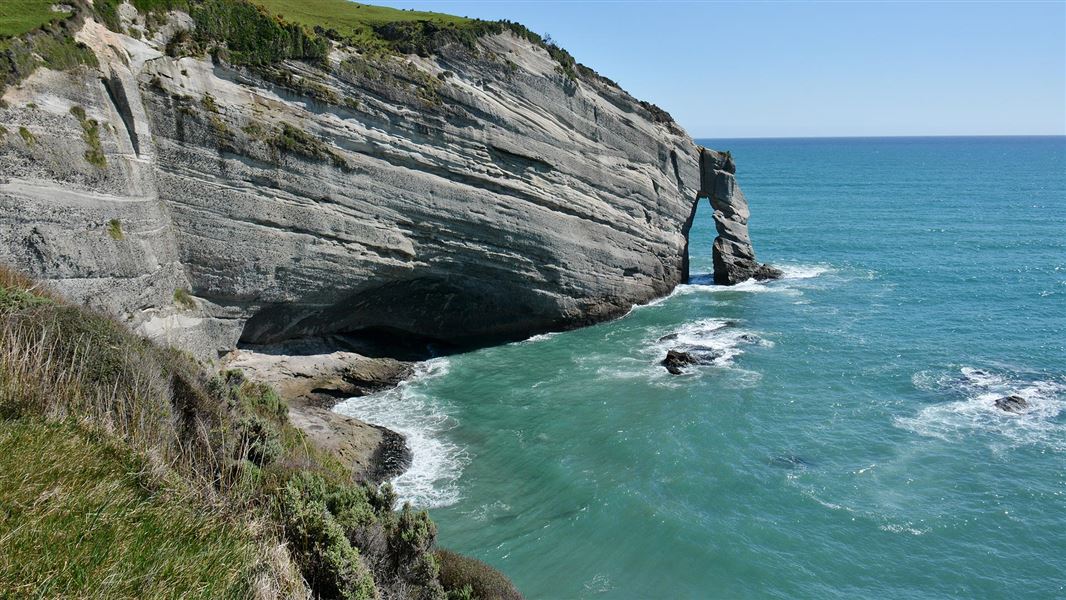From Takaka, follow State Highway 60 north to Farewell Spit.
Public transport
There is no public transport to Puponga. Two DOC-approved operators run nature tours to Farewell Spit Lighthouse.
You can freely enjoy Puponga Farm Park and can walk a short distance along the base of Farewell Spit. There is no public access elsewhere on the Spit except by DOC permit or with a licensed tour operator.
- No dogs or other pets are allowed.
- Firearms are prohibited.
- Camping is not permitted on both the Spit reserve and the Farm Park.
- Take your rubbish away with you when you leave.
- Do not light fires or smoke;
- Care is required in windy conditions on the Pūponga Hilltop Walk.
- Keep at least 20 metres away from seals.
At Farewell Spit
Quicksand hazard at the public access area: There is an intermittent issue with quicksand within the flat sand pans at the base of Farewell Spit. This hazard exists in the flat open sand areas within the dunes, not out on the beach. The beaches, marked tracks and roads are still safe for travel.
Foot access only - no vehicles or bikes are permitted past the car park.
At Pūponga Farm Park
Seemingly harmless acts, such as leaving a gate open or taking a pet for a walk can have drastic consequences for farm management. Follow these rules when visiting the farm:
- cars and motorcycles must stay on formed roads and car park areas
- leave gates as you find them; don't be tempted to close an open gate - it's open for a purpose!
- hay and bull paddocks and the airstrip (during operations) are off limits to visitors
- livestock, birds and plants are not to be disturbed or interfered with
- at times the farm may be closed to the public. This is usually during lambing or calving, or when the fire risk is extreme. During such times, visitors are asked to keep to roads and car parks.
Farewell Spit, at the tip of the South Island, is New Zealand’s longest sand spit (25 km) and a nature reserve. It is an internationally-renowned bird sanctuary with over 90 bird species recorded in the area.
Every spring, thousands of wading birds arrive from the northern hemisphere. Other birds range from black swans to sparrows. Penguins also breed in the area.
The area's attractions include a historic lighthouse, pa sites, the seals and striking landforms of Wharakiki Beach and a cliff top viewing platform.
The caves, islands, and arches of Wharariki Beach, where seals breed, are among the most dramatic in the country. Behind are constantly shifting dunes and a series of lakes and swamps. The vegetation is diverse, with some very rare plants.
The part of the spit that forms the Ramsar Wetland site, covering 11 388 ha, is managed by the Department of Conservation as a Nature Reserve and Shorebird Network Site. The spit is ramsar site number 103, listed on 13 August 1976. This wetland area is both estuarine and freshwater.
There is much evidence of Maori occupation in this area. Some is associated with the hunting of moa (now extinct) and harvesting of other foods. Pūponga Point, once the site of a pa/fort, is one of many archeological sites.
In 1642, Abel Tasman was the first European to visit the area. In 1770, Captain Cook named it Farewell Spit as he left New Zealand. In 1870, the first lighthouse was built to prevent shipwrecks, which occurred frequently. Grazing of Farewell spit stopped in the late 1930s, but Pūponga Farm Park is today a working farm operating under a DOC lease.
Whakatū/Nelson Visitor Centre
| Phone: | +64 3 546 9339 |
| Email: | nelsonvc@doc.govt.nz |
| Address: | Millers Acre/Taha o te Awa 1/37 Halifax Street Nelson 7010 |
| Hours: | Visitor centre hours and services |
